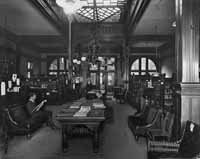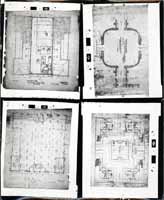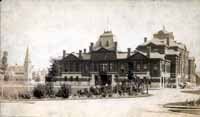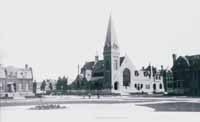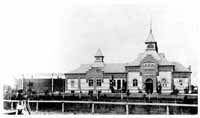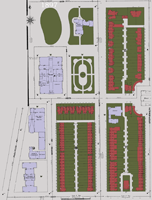The Arcade
You are at Home -> The Town of Pullman -> The Arcade BuildingThe Arcade
The Arcade was completed in June of 1882, and was envisioned as one of the main social complexes of Pullman. The largest non-factory building in the town, the Arcade was a block long, covered about an acre, and contained shops, a library, a theater, other general-use rooms, and offices on its first and second floors. A third story held meeting rooms for various lodges, including the Masons and Odd Fellows. A precursor of the modern shopping center, the Arcade was designed with dry-goods shops on the main and second floors rented to various proprietors; a subscription library on the second floor; and an ornate 1,000-seat theater, also on the second floor. In May of 1883, the Pullman Loan and Savings Bank moved into the northeast corner of the Arcade, with a post office (northwest corner) also joining the list of tenants.

Plans for the first floor of the Arcade |

Plans for the second floor of the Arcade |
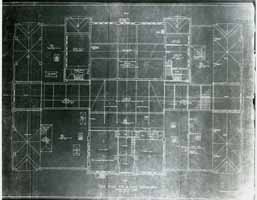
Plans for the third floor of the Arcade |
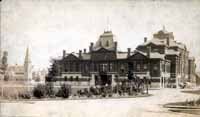
The Arcade building from the north |

South entrance |
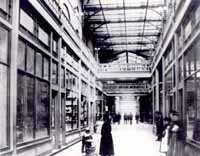
First floor interior |

Second floor interior |
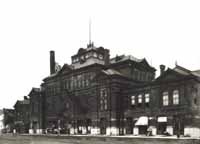
The last days of the Arcade. Photo, circa 1925. |
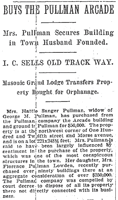
Article on the Pullman family purchasing the Arcade in 1907 (Chicago Tribune, 12/25/1907, p. 12) |
See a listing of who worked in the Arcade Building.
Shopping in the Arcade
Shoppers of the 1880s might have meandered down the aisles of the Arcade Building looking into store windows at shoes, clothing, china and glassware, furniture, jewelry, or hardware. They may have shopped for tobacco, some groceries, "dry goods" (also known as "soft goods," and including bedding, hosiery, gloves, fabrics, ribbon, lace, silk, and other textiles, as distinct from groceries) or availed themselves of the services of a tailor, dressmaker, barber, insurance agent, doctor, or dentist. An interesting early tenant of the Arcade was a retail establishment operated by John Hopkins (also one of the initial members of the library's Advisory Board) and Frederick Secord, the Arcade Trading Company. Hopkins initially worked for the Pullman's Palace Car Company as a construction worker, but his skills and talents helped him rise to "head timekeeper" for the car shops by 1881. The Arcade Trading Company rented four stores in the Arcade in 1886, and Hopkins not only kept his job, but also apparently secured a secret agreement for a rent rebate for the stores. After a rift between Hopkins and Pullman- most probably caused by Hopkins' support and efforts on behalf of Pullman annexation to Chicago, a switch of Hopkins' political party allegiance, and an 1888 reneging on the part of Pullman for the promised rebate- the store relocated to Kensington (Hopkins sued Pullman over the rebate issue, but eventually the company won). After Chicago mayor "Our Carter" Harrison was assassinated in October 1893, Hopkins won a narrow victory to become Chicago's new mayor- and was thus mayor during the Pullman Strike of 1894. The vacant space after Hopkins and Secord left was assumed in 1889 by the Arcade Mercantile Company, a venture (Hopkins asserted) of Edward F. Bryant (the lyrical-advertising bank manager; see above) and Duane Doty (the town agent). A delightful photograph in the Chicago Historical Society Pullman Photograph Collection shows a view of first floor shops with an Arcade Mercantile Company sign in the main aisle reading "To the People of Pullman, Roseland and Kensington. Save time and car fare by buying your goods at the Arcade Mercantile Co. at lowest Chicago prices." Because of quick and easy access to surrounding communities and Chicago, Arcade shops had to have competitive pricing. There was also apparently some effort made to rent spaces to ensure "necessary competition."The Arcade Theater

Composited image of the Arcade Theater
Note that this image was created from Photoshop by melding together 2 Johnson photographs.
More information...
The 1,000 seat theater in the Arcade was dedicated January 9, 1883, with an address by Stewart Woodford, of New York, and the play "Esmeralda," put on by the Madison Square Theatre company. To reach the theater, one ascended a massive stairway from the west central entrance of the Arcade to a hallway decorated with a sky-blue ceiling "bespangled with stars." A giant gas chandelier hung from the frescoed ceiling inside the theater, which had five elegant and ornately-decorated boxes on each side of the main seating area, extending from a balcony. Seats in the orchestra were covered in red leather.The Pullman Bank

Interior of the Pullman Bank in the Arcade Building
Image generously donated by the Lake County Discovery Museum, Curt Teich Postcard Archives
More information...
The Pullman Bank occupied the N.E. corner of the first floor. The bank first relocated to 111th and South Park Avenue (now King Drive) and when it outgrew that space, moved to the present location at 111th and Doty (a street named after the town's first manager). The bank is privately owned.The Arcade Library
More information...
The library contained more than 6,000 volumes, most being George Pullman's personal donation. Library cards cost $3.00 a year for adults and $1.00 a year for children. The library was housed in four elegant rooms in the NE corner of the second floor. These rooms had stained glass windows, chandeliers, Wilton carpets and upholstered furniture which gave the rooms the feel of a gentlemen's club. There was also an austere fifth reading room that was furnished plainly and had a separate entrance. This was for factory workers who might not feel comfortable in the other rooms. Evening classes for adults were held here and included classes in stenography, art, language, and literature. Lucy Fake was the first librarian; another important librarian was Bertha Ludlam, cousin of George M. Pullman. The collection eventually became a part of the Pullman Branch of the Chicago Public Library.THE PULLMAN HISTORY SITE

More Information About the Town of Pullman
Planning the town
The Arcade Journal
The Hotel Florence
The Arcade
Arcade Park
The Stables
Market Hall
Area Churches
Area Schools
The Freight Depot and the Railway Station
Other Pullman Buildings
The Pullman House History Project
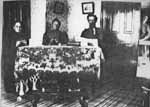
Arranged by:
Name
Address
Occupation
Birthplace
People of Color
Maps of Pullman
Images of the Town of Pullman
All images of the town
Vistas
Art & Architecture
- Landscape architect Nathan Franklin Barrett
- Architect Solon Spencer Beman
- Henry Koopman and Family, Photographer
- Landscape Design
Pullman’s Neighborhood
- The Calumet River
- IHACCR
- Area Churches
- The Kensington Neighborhood
- Lake Calumet
- North Pullman
- The Roseland Neighborhood
Buildings in Pullman
- The Arcade Building
- Arcade Park
- Carriage House
- Casino Building
- Fire Department
- Freight Depot
- Gas Works
- The Hotel Florence
- Hospital
- Houses
- Market Hall
- Schools
- Stable
- Train Station
Other Pullman-Related Sites
- Historic Pullman Garden Club - An all-volunteer group that are the current stewards of many of the public green spaces in Pullman. (http://www.hpgc.org/
- Historic Pullman Foundation - The HPF is a non-profit organization whose mission is to "facilitate the preservation and restoration of original structures within the Town of Pullman and to promote public awareness of the significance of Pullman as one of the nation's first planned industrial communities, now a designated City of Chicago, State of Illinois and National landmark district." (http://www.pullmanil.org/)
- The National A. Philip Randolph Pullman Porter Museum is a 501(c)3 cultural institution. Its purpose is to honor, preserving present and interpreting the legacy of A. Philip Randolph, Pullman Porters, the Brotherhood of Sleeping Car Porters and the contributions made by African-Americans to America's labor movement. ((http://www.nationalpullmanportermuseum.com/)
- Pullman Civic Organization - The PCO is a strong and vibrant Community Organization that has been in existence since 1960. (http://www.pullmancivic.org/)
- Pullman National Monument - The official page of the Pullman National Park. (https://www.nps.gov/pull/)
- South Suburban Genealogical & Historical Society - SSG&HS holds the Pullman Collection, consisting of personnel records from Pullman Car Works circa 1900-1949. There are approximately 200,000 individuals represented in the collection. (https://ssghs.org/)
- The Industrial Heritage Archives of Chicago's Calumet Region is an online museum of images that commemorates and celebrates the historic industries and workers of the region, made possible by a Library Services and Technology Act grant administered by the Illinois State Library. (http://www.pullman-museum.org/ihaccr/)
- Illinois Digital Archives (IDA) is a repository for the digital collections libraries and cultural institutions in the State of Illinois and the hosting service for the online images on this site. (http://www.idaillinois.org/)
